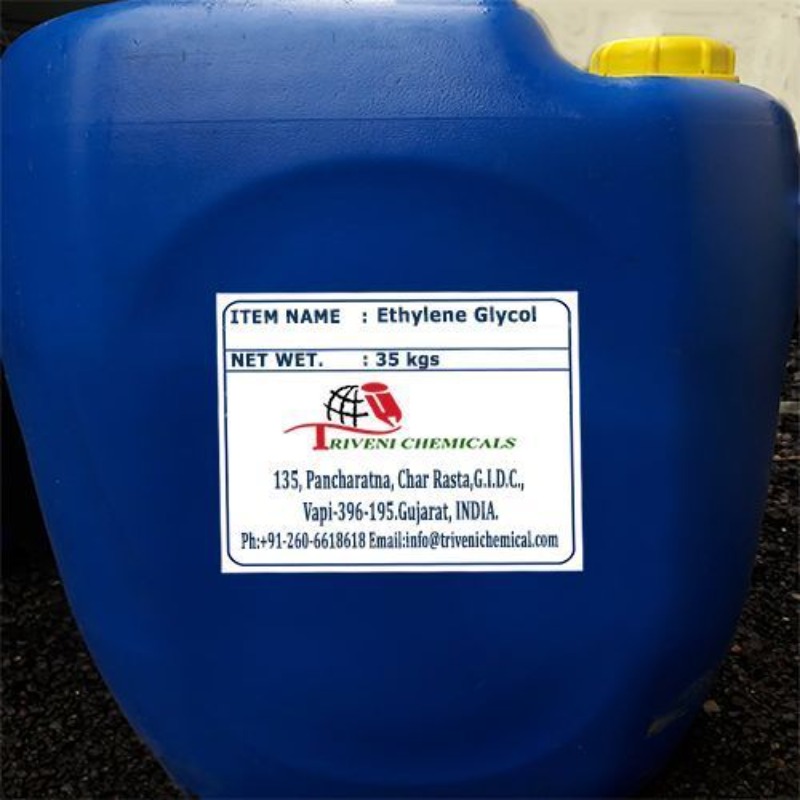Ethylene Glycol (Technical Grade)
Key Points
- Chemical Formula: Ethylene glycol has the chemical formula C₂H₆O₂. It is a simple diol with two hydroxyl groups attached to a two-carbon chain.
- Physical Properties: It is a colorless, odorless, sweet-tasting liquid that is viscous and hygroscopic. It has a boiling point of 197.3°C and a melting point of -12.9°C.
- Solubility: Ethylene glycol is highly soluble in water and various organic solvents, making it versatile for different applications.
- Toxicity: It is moderately toxic if ingested, inhaled, or absorbed through the skin, with potential harmful effects on the kidneys and central nervous system.
- Industrial Grade: Typically available in different grades, including industrial, technical, and laboratory grades, each with varying levels of purity and suitable for different applications.
- Stability: It is chemically stable under normal conditions but can react with strong oxidizing agents. It does not evaporate easily due to its low vapor pressure.
Uses of Ethylene Glycol (Key Points)
- Antifreeze and Coolant: Primarily used in automotive antifreeze and coolant formulations due to its ability to lower the freezing point and raise the boiling point of water.
- Heat Transfer Fluid: Utilized in heating, ventilation, and air conditioning (HVAC) systems, and industrial cooling systems as a heat transfer fluid.
- Chemical Intermediate: Acts as a precursor in the production of polyester fibers, resins, and other polymers, as well as in the synthesis of various chemicals.
- Deicing Agent: Employed in deicing solutions for aircraft and runways, as it effectively lowers the freezing point of water.
- Hydraulic and Brake Fluids: Used in some formulations of hydraulic and brake fluids due to its lubricating properties and high boiling point.
- Solvent: Used as a solvent in various applications, including paints, inks, and plastics, due to its ability to dissolve a wide range of substances.
Precautions When Using Ethylene Glycol (Key Points)
- Toxicity Awareness: Be aware of its toxicity. Avoid ingestion, inhalation, and skin contact. Use in well-ventilated areas and wear appropriate personal protective equipment (PPE) such as gloves, goggles, and protective clothing.
- Storage: Store in a tightly sealed container in a cool, dry, well-ventilated area, away from heat sources and incompatible substances like strong oxidizers.
- Handling Spills: In case of a spill, contain and clean up immediately using appropriate absorbent materials. Dispose of cleanup materials and waste according to local regulations.
- First Aid Measures: Know the first aid measures for exposure. In case of ingestion, seek immediate medical attention. For skin or eye contact, rinse thoroughly with water and seek medical advice if irritation persists.
- Fire Hazard: Although not highly flammable, ethylene glycol can ignite if exposed to a flame. Keep away from open flames and sources of ignition. Use appropriate fire extinguishers for chemical fires.
- Environmental Impact: Prevent release into the environment. Ethylene glycol can be harmful to aquatic life. Dispose of it properly and avoid pouring it down the drain or into waterways.
If you'd like to know more about this chemical or need any analysis report regarding this chemical then contact us: support@echem.com.bd.
Ethylene Glycol (Technical Grade)
Purity % | 98% |
Chemical Formula | C2H6O2 |
Physical State | Liquid |
Density | 1.11 g/cm3 |
Melting Point | -12.9degC |
Boiling Point | 197degC |
Molar Mass | 62.07 g/mol |

Login To Comment